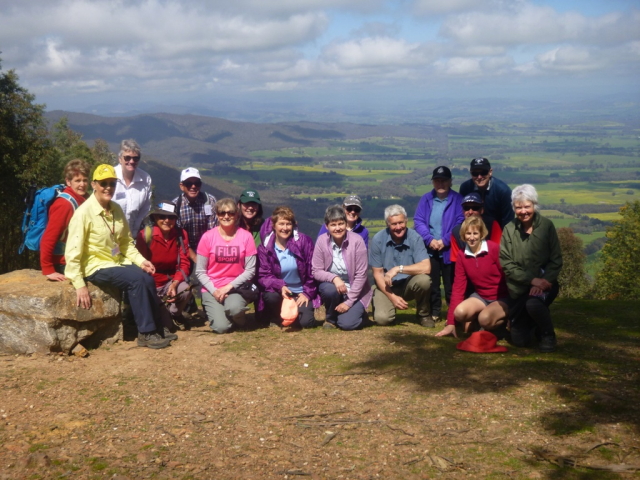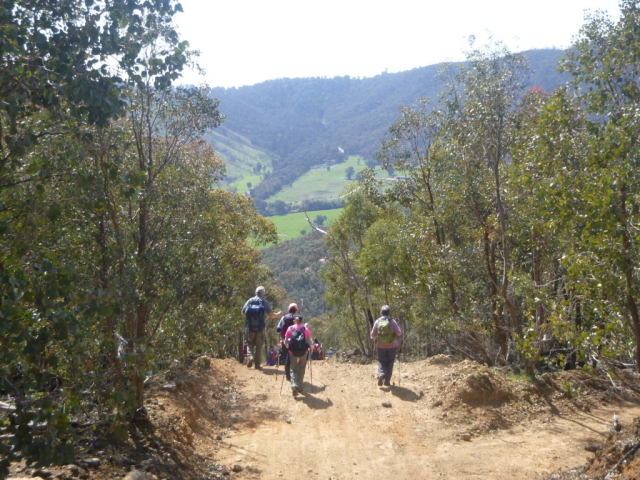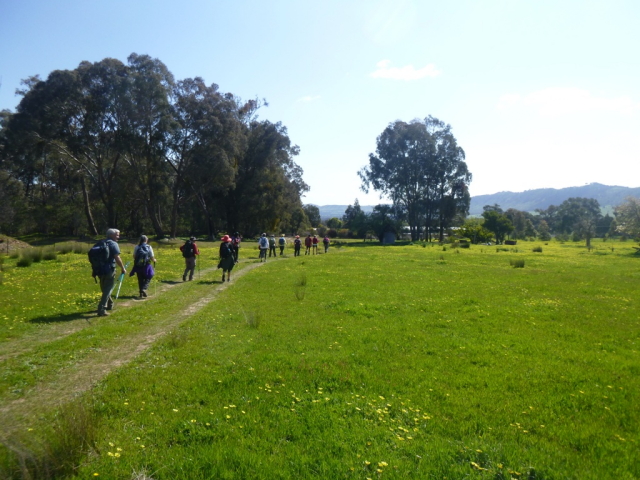On a fantastic day of sunshine, with a chilly breeze at times, 17 walkers, including two casuals from Wodonga, joined this walk of about 11k.
We started at the intersection of Buckland Gap Road and Lady Newton Drive, and after a few hill climbs, we were rewarded with fantastic views from the lookout, where we had morning tea.
Continuing onto Burgoigee Road, and then Flagstaff Road, we had lunch under the shady trees at the intersection with Murmungee Track. We could see the descent ahead, the challenging part of the walk.
Taking care with footing, and equipped with walking poles, the challenging two kilometre descent, which was quite steep in parts, was completed.
We were rewarded at the base of the descent, where Lyn spotted the remaining ruins of the Weone Mine, there has been plenty of dirt dug over here in years gone by.
A mishap negotiating the fallen logs beside the track had one walker suffer a bump to their shin, which resulted in a large lump thereon, followed by attendance by our nursing walkers.
A short trek down the beautiful Ellen Lane, with its large grand old trees, brought us to afternoon tea beside the Buckland Gap Road.
[Jeanette]
Historical Information and Heritage Inventory
Gold was discovered in Cunningham’s Gully in 1858.
Reefs were opened in the vicinity from the mid-1860s, the first of them being McLean’s Reef, discovered by alluvial miners in McLean’s Gully.
A water-powered battery was erected in Cunningham’s Gully by Dean & Co. in 1868, to crush for their King, Annandale, Solway reefs.
The Murmungee – Bowman’s Forest reefs were briefly the major gold producers on the Beechworth field.
Operations at that time were short-lived, though, due in part to the scarcity of water in the locality, and the battery was removed in 1871.
When the Bowman’s Forest reefs were revived in the mid-1880s, a steam-driven battery was erected at Murmungee by George Biddington.
Development of the reefs was again limited to surface scratchings, where rich stone was easily procured.
The mining registrar wrote of the reefs in 1887 that ‘up to the present none of them have developed into good permanent reefs’.
There were small parties working on reefs about Murmungee early this century.
One of them, Wells and party, erected a small battery on their prospecting claim on McLean’s Reef in 1915.
The party was still prospecting in 1917. The fate of the 1915 battery is not known, but according to information cited by the National Trust, the existing plant was erected in 1939 and the mine, known as the Weone, worked (unprofitably) until the late ‘forties by Walter Wells and his son Max.
They crushed stone, not just from the Weone, but from various quartz shows in the vicinity.
The shallow workings evident near the battery today suggest that the Murmungee quartz workings never progressed much beyond the surface scratchings noted in the mid-1880s.
In the early 1980s, the local branch of the National Trust proposed that the waterwheel and other remaining plant be re-sited to Beechworth, after the theft of several components from the Cunningham Gully site.
The plant is still owned by Max Wells.
Source – https://vhd.heritagecouncil.vic.gov.au/places/10962



